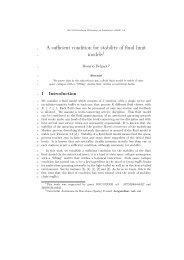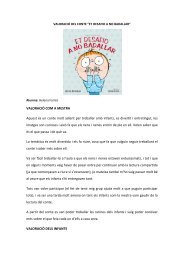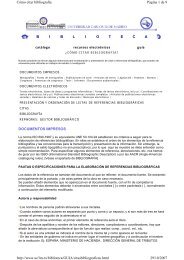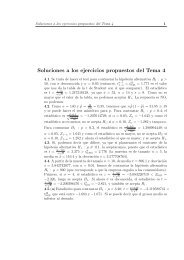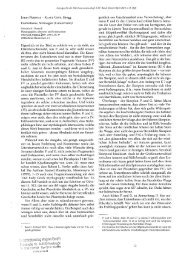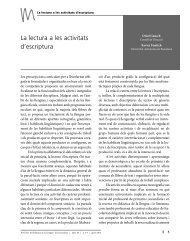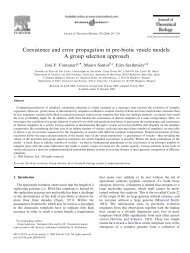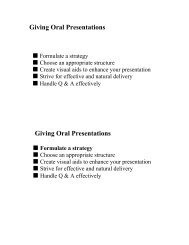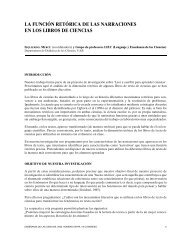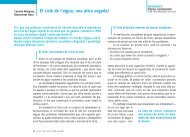please do not cite without permission from the authors
please do not cite without permission from the authors
please do not cite without permission from the authors
You also want an ePaper? Increase the reach of your titles
YUMPU automatically turns print PDFs into web optimized ePapers that Google loves.
opportunities and improve <strong>the</strong>ir competitiveness as against o<strong>the</strong>r countries of<strong>the</strong> Centre and <strong>the</strong>ir respective peripheries.The logic of this strategy includes restructuring <strong>the</strong> relations between <strong>the</strong> EUand its former African colonies known as <strong>the</strong> ACP countries (Africa, Caribbeanand Pacific). These countries were previously organized within <strong>the</strong> successiveLomé Conventions (I–IV). But in <strong>the</strong> year 2000 <strong>the</strong> signing of <strong>the</strong> CotonouAgreement opened <strong>the</strong> way to a series of changes to <strong>the</strong> previous structure,leading to <strong>the</strong> signing of Economic Partnership Agreements (EPAs). Thesewere supposed to pave <strong>the</strong> way for <strong>the</strong> future establishment of large free tradezones between <strong>the</strong> EU and various already established regional groups inSub-Saharan Africa (SSA).The drawn-out negotiation processes of <strong>the</strong> EPAs reflect intensedisagreements about <strong>the</strong>ir potential effects. The sou<strong>the</strong>rn region of <strong>the</strong> Africancontinent is representative of <strong>the</strong> polemics which <strong>the</strong>se moves are generating,and of <strong>the</strong>ir negative and positive effects on conditions for development, bothfor individual countries and for <strong>the</strong> region’s most important integration project,SADC (<strong>the</strong> Sou<strong>the</strong>rn African Development Community). Since <strong>the</strong> negotiationsand interim agreements have now gone beyond <strong>the</strong> opening debates in favourof or against <strong>the</strong> proposed new framework, it is a fitting moment to ask whatkind of EPAs, or relations with <strong>the</strong> EU, <strong>the</strong> countries of <strong>the</strong> region shouldpursue in order to accelerate <strong>the</strong>ir development (Goodison, 2009).2. African regional integration and <strong>the</strong> new regionalismRegional initiatives in Africa arose as part of <strong>the</strong> process of gaining politicalindependence; <strong>the</strong>y were supported by a pan African philosophy whicha<strong>do</strong>pted a pragmatic approach towards <strong>the</strong> various regional groupings <strong>the</strong>nunderway, treating <strong>the</strong>m as pieces in a continent-wide jig-saw which woul<strong>do</strong>ne day be completed.Decades of structural adjustment, however, as well as <strong>the</strong> recent impasse of<strong>the</strong> WTO’s trade negotiations, have given rise to a new form of regionalism –one which interprets integration initiatives more as ‘building blocks’ than‘stumbling blocks’ in <strong>the</strong> broader concept of a liberalization which incorporates2
<strong>the</strong> whole world. There is growing support for regional integration, understoodas a synonym for economic liberalization in a defined multi-state area, as longas it is <strong>not</strong> an obstacle but a step on <strong>the</strong> way towards an eventual deregulationand complete opening up on a world scale on <strong>the</strong> lines of <strong>the</strong> currentneoliberal globalization model (Panagariya, 1999; Bhagwati , et al., 1998;Bhalla and Bhalla, 1997).This new <strong>not</strong>ion of open regionalism means at <strong>the</strong> same time a spatialextension of <strong>the</strong> concept of region to groupings with a continental or evenintercontinental membership, exemplified in <strong>the</strong> initiatives towards integrationbetween countries with major differences in <strong>the</strong>ir socio-economic levels(North–South regionalism). This idea has given rise to a number of projectssuch as <strong>the</strong> North American Free Trade Agreement, 1 <strong>the</strong> Central AmericanFree Trade Agreement, and <strong>the</strong> currently paralysed Free Trade Area of <strong>the</strong>Americas (to include <strong>the</strong> whole of <strong>the</strong> American continent), as well as similarlyextensive projects in o<strong>the</strong>r continents, between <strong>the</strong> countries of ASEAN andChina for instance, or between countries in <strong>the</strong> ACP group and <strong>the</strong> EUfollowing <strong>the</strong> end of <strong>the</strong> Lomé era.While such initiatives have often been interpreted as an intermediate steptowards freer trade and investment on a world scale, <strong>the</strong>ir real meaning canalso be seen <strong>from</strong> a<strong>not</strong>her viewpoint – one which sees <strong>the</strong>m as part ofcompeting attempts by <strong>the</strong> countries of <strong>the</strong> Centre to maintain and extend <strong>the</strong>irtrade and investment activities by means of formal agreements with countries<strong>the</strong>y regard as part of <strong>the</strong>ir sphere of influence (Bidaurratzaga y Colom, 2005,Bowles, 2002; Hettne et al., 1999).In any event, this new pattern of extended regionalism is part of a concept ofintegration which on <strong>the</strong> one hand one appears to reduce it merely to tradeissues, involving very limited institutionalization beyond free trade areas, butwhich, on <strong>the</strong> o<strong>the</strong>r hand, extends <strong>the</strong> number of questions which areconsidered to be ‘trade-related’ (including such questions as intellectualproperty, liberalization of FDI, public contacts, competition policy and so forth).1 The North American Free Trade Agreement, in force since 1994, is composed of <strong>the</strong> USA,Canada and Mexico. The Central America Free Trade Agreement comprises <strong>the</strong> DominicanRepublic, Costa Rica, El Salva<strong>do</strong>r, Guatemala, Honduras, and Nicaragua and <strong>the</strong> USA. Itcame into force in 2006.3
This kind of pattern has come to be known as <strong>the</strong> ‘WTO+’ norms, given thatits elements include more than <strong>the</strong> current WTO agreements on such issues.At <strong>the</strong> same time, very little attention is given to compensatory mechanismswhich might help to redistribute <strong>the</strong> costs and benefits of integration on anequitable basis between countries at very different levels of development.Even when equitable measures <strong>do</strong> exist <strong>the</strong>ir level and extent are very limitedand insufficient to compensate for <strong>the</strong> adjustment costs (Goodison, 2009;Bidaurratzaga y Marín, 2006).3. Changing approaches: <strong>from</strong> Lomé to CotonúThe Lomé model, born in 1975 in <strong>the</strong> form of Lomé I (<strong>the</strong> successor to <strong>the</strong>Yaundé I and II conventions) was <strong>the</strong> main pattern within which relationsbetween Western Europe and its former ACP colonies were managed up to<strong>the</strong> expiry of Lomé IV in 2000. The convention brought toge<strong>the</strong>r 48 Sub-Saharan African countries 2 of which three quarters were Least DevelopedCountries (LDCs).The Lomé Conventions shaped <strong>the</strong> general development aid policy of <strong>the</strong>EEC, which apart <strong>from</strong> <strong>the</strong> specific fields of technical assistance and financialaid (implemented through <strong>the</strong> European Development Funds: EDF I–VIII), hadas one of <strong>the</strong> central elements of this policy <strong>the</strong> preferential non-reciprocalaccess to <strong>the</strong> European market for products <strong>from</strong> <strong>the</strong> ACP countries. 3 On <strong>the</strong>one hand, this was interpreted as being an element of positive discriminationin favour of <strong>the</strong> SSA countries, and as such formed part of post-colonial movestowards a New International Economic Order which could potentiallycontribute to socio-economic development. On <strong>the</strong> o<strong>the</strong>r hand, <strong>the</strong> system2 The only countries remaining outside <strong>the</strong>se agreements are <strong>the</strong> five North African countries,which at present have <strong>the</strong>ir own specific framework of relations with <strong>the</strong> EU and <strong>the</strong> non-African countries of <strong>the</strong> Mediterranean region.3 Apart <strong>from</strong> <strong>the</strong> special rules for certain goods such as bananas, beef, rum and sugar, <strong>the</strong>agreements basically included manufactured and agricultural products which did <strong>not</strong> competewith products included in <strong>the</strong> European Common Agricultural Policy (CAP), in o<strong>the</strong>r wordsgenerally tropical products. As well as <strong>the</strong> areas such as humanitarian aid or structuraladjustment financing, found in most development aid programmes in previous decades, <strong>the</strong>Lomé Conventions included in <strong>the</strong> trade field some more unusual elements, such as Stabexand Sysmin, which were designed to stabilise export incomes <strong>from</strong> agricultural and miningproducts respectively.4
also helped European countries, by providing <strong>the</strong>m with privileged access toAfrican raw materials at a time when <strong>the</strong>ir prices were rising on world markets.After <strong>the</strong> review of Lomé IV in 1995, a debate opened up about <strong>the</strong> results of<strong>the</strong> Conventions and <strong>the</strong> need to change <strong>the</strong> existing pattern of relations. Thefirst major intervention in this discussion was provided by <strong>the</strong> publication of <strong>the</strong>so-called ‘Green Paper’, in which for <strong>the</strong> first time <strong>the</strong> European Commissionformally launched its main arguments for a basic re-examination of <strong>the</strong> existingscheme.In this <strong>do</strong>cument <strong>the</strong> Commission emphasised its dissatisfaction with <strong>the</strong>previous model with regard to both its ambitious general aims (povertyreduction and faster economic and social development) and also its lesser andmore concrete targets (<strong>the</strong> share of <strong>the</strong> ACP countries’ exports in Europeanmarkets). In fact, <strong>the</strong> percentage participation of EU imports <strong>from</strong> ACPcountries (and <strong>from</strong> SSA) had fallen ra<strong>the</strong>r than risen. There was a majorcontrast here with o<strong>the</strong>r developing economies, especially in Asia, which hadincreased <strong>the</strong>ir share of <strong>the</strong> European market even though <strong>the</strong>y had receivedno preferential treatment. 4Figure 1 shows <strong>the</strong> imports of <strong>the</strong> EU(27) <strong>from</strong> various country groups,including <strong>the</strong> ACP countries and <strong>the</strong> member countries of SADC, for <strong>the</strong> years1999 to 2009. Unlike some o<strong>the</strong>r regions, and some Asian countries inparticular, <strong>the</strong> percentage of <strong>the</strong>se two groups in EU imports <strong>do</strong>es <strong>not</strong> increasealthough for both groups <strong>the</strong> absolute volume of imports did growsignificantly. 54 To be precise, between 1976 and 1992 <strong>the</strong> ACPs share of EU imports fell <strong>from</strong> 6.7 to 3.7percent although in volume terms ACP exports to <strong>the</strong> EU grew at 2 percent a year. This wasmuch slower than <strong>the</strong> annual growth of exports to <strong>the</strong> EU <strong>from</strong> Mediterranean countries (6percent) or Asian countries (12 percent) (Goodison and Stoneman, 2005).5 In absolute terms imports <strong>from</strong> ACP countries rose by 60.4 percent between 1999 and 2009but <strong>the</strong>ir importance as sources of EU27 imports stayed constant, at around 4.5 percent. EU27imports <strong>from</strong> SADC rose by 44.7 percent in <strong>the</strong> same decade; <strong>the</strong>ir share was slightly above 2percent in some years but fell to 2 percent in 2009. The so-called ‘dynamic Asian economies’(DAE: South Korea, Hong Kong, Malaysia, Singapore, Taiwan, Thailand) increased <strong>the</strong>irexports to <strong>the</strong> EU27 by 12.9 percent in absolute value, which, given <strong>the</strong> general increase inEU imports, <strong>the</strong>ir share fell by 3.6 percentage points. The most spectacular increase, both intotal value and in percentage of <strong>the</strong> total, was <strong>from</strong> China (excluding Hong Kong). Totalexports rose by 60.4 percent between 1999 and 2009 while China’s share of EU importsremains constant at 4.5 percent.5
Figure 1. Shares of various groups of countries in <strong>the</strong> imports of <strong>the</strong> EU(27), 1990–2008Million Euros and percentage of total EU imports300.00020,018,0250.00016,0Million Euros200.000150.000100.00014,012,010,08,06,0Percentage of total EU imports50.0004,02,001999 2000 2001 2002 2003 2004 2005 2006 2007 2008 20090,0Source: EUROSTATSADC total ACP total Lat_Am total DAE total CN excl. HK totalSADC % ACP % Lat_Am % DAE % CN excl. HK %During <strong>the</strong> Lomé era, Asian and Latin American countries generally increased<strong>the</strong>ir volume of exports to <strong>the</strong> European market more than <strong>the</strong> ACP countries.None<strong>the</strong>less, it is important to <strong>not</strong>e that when <strong>the</strong>re was a higher margin ofpreference compared with o<strong>the</strong>r developing countries <strong>the</strong> increase in exports<strong>from</strong> <strong>the</strong> ACP countries was substantially greater. 6 Also, <strong>the</strong> results are betterfor certain countries which received more trade advantages than those offeredby <strong>the</strong> basic Lomé non-reciprocal preference scheme (in <strong>the</strong> form of quotas,6 In o<strong>the</strong>r words, although <strong>the</strong> volume of exports of ACP countries to <strong>the</strong> EU grew only 3.6percent between 1988 and 1997, <strong>the</strong> number of products receiving preference of more than3% above <strong>the</strong> GSP level grew by 61.9 percent (17 times as fast). In <strong>the</strong> case of SADC, thisdisaggregation of <strong>the</strong> data shows an even more marked contrast: during <strong>the</strong> same period <strong>the</strong>overall volume of exports fell by 5.4 percent, whereas <strong>the</strong> products receiving more than 3percent preference above <strong>the</strong> GSP level grew by 83.6 percent (Goodison and Stoneman,2005; Davies and Mbuende, 2002; Goodison, 2000).6
for instance). 7 For this reason some writers have questioned <strong>the</strong> honesty of<strong>the</strong> EU when it declares <strong>the</strong> Lomé system to have been a failure, given that<strong>the</strong> EU fails to mention o<strong>the</strong>r problems of a structural, supply-side nature inSSA countries, such as <strong>the</strong>ir specialisation in a limited range of primaryproducts which were facing over-supply and falling prices in <strong>the</strong> world market.The erosion of <strong>the</strong> level of preference due to <strong>the</strong> advance of <strong>the</strong> GATTliberalization programme was a<strong>not</strong>her reason why <strong>the</strong> argument that Loméfailed is an exaggeration. These points suggest that <strong>the</strong> verdict on <strong>the</strong>previous preferential system is a good deal more complex than <strong>the</strong> EU hasadmitted (Mold, 2007, Goodison and Stoneman, 2005; Hurt, 2003).Moreover, if <strong>the</strong> preferences had been such a failure it would be hard tounderstand why African governments insist that <strong>the</strong> old model should beretained, as well as <strong>the</strong> fact that <strong>the</strong> EU itself proposed to continue nonreciprocalpreferences for <strong>the</strong> worst-off economies (<strong>the</strong> LDCs) ra<strong>the</strong>r thansubmit <strong>the</strong>m to <strong>the</strong> reciprocal trade rules of <strong>the</strong> EPAs (Faber and Orbie, 2009).The EU’s arguments highlight <strong>the</strong> incompatibility between <strong>the</strong> Lomé model and<strong>the</strong> WTO principles in relation to reciprocity and non-discrimination. 8 Also <strong>the</strong>importance of differentiating between different ACP countries on <strong>the</strong> basis of<strong>the</strong>ir level of development, by giving more favourable conditions to <strong>the</strong> LCDs,led <strong>the</strong> European Commission to stress <strong>the</strong> need for changing <strong>the</strong> Lomémodel. In spite of <strong>the</strong>se incompatibilities, it has been possible in recent yearsto continue to apply <strong>the</strong> Lomé model thanks to <strong>the</strong> acceptance of two requestsby <strong>the</strong> EU for temporary exemptions <strong>from</strong> <strong>the</strong> WTO multilateral norms, <strong>the</strong> lastof <strong>the</strong>se expiring on <strong>the</strong> 31 December 2007. The possibility that <strong>the</strong> EU couldcontinue to press for temporary exemptions has also been mentioned by7 Countries such as Botswana, Swaziland, Namibia, Mauritius and Zimbabwe had significantlyincreased <strong>the</strong>ir income in <strong>the</strong> SADC thanks to <strong>the</strong> advantages offered by special protocols forsugar and beef. These facts, in contrast to <strong>the</strong> general opinion about <strong>the</strong> effectiveness of <strong>the</strong>Lomé Agreements, show that for <strong>the</strong> favoured nations preferential trade has played animportant role in ensuring that <strong>the</strong> SACD countries are <strong>not</strong> marginalised <strong>from</strong> internationaltrade flows (Goodison, 2000; Matambalya, 1998).8 The exception to <strong>the</strong> principle of reciprocity, using <strong>the</strong> controversial Article XXIV on regionalintegration agreements, was <strong>not</strong> applicable. And in relation to <strong>the</strong> Most Favoured Nationclause, which signified <strong>the</strong> absence of discrimination, <strong>the</strong> Lomé non-reciprocal preferencesystem was authorized in <strong>the</strong> form of an exception using <strong>the</strong> Habilitation Clause. Thispermitted Lomé, as long as such advantages were given to all developing economies and <strong>not</strong>merely some of <strong>the</strong>m (Solignac-Lecomte, 2001; Gibb, 2000; McQueen, 1998).7
several writers as evidence of <strong>the</strong> EU’s lack of political willingness to searchfor models more in accord with <strong>the</strong> interests of <strong>the</strong> ACP countries (Faber andOrbie, 2009; Mold, 2007, Hurt, 2003).None<strong>the</strong>less, at <strong>the</strong> end of 1998 <strong>the</strong> process of negotiation began which wouldgive birth to <strong>the</strong> Cotonú Agreement. In <strong>the</strong> negotiations <strong>the</strong> EU pressedstrongly for a major reorientation of previous agreements towards a new onebased on reciprocal liberalization of trade, as a way of improving <strong>the</strong> efficiencyand competitiveness of <strong>the</strong> productive systems of <strong>the</strong> ex-colonies and <strong>the</strong>ircapacity to participate in <strong>the</strong> world economy. Para<strong>do</strong>xically, <strong>the</strong> standpoint of<strong>the</strong> representatives of <strong>the</strong> ACP countries was very different. They alwayspressed for extending <strong>the</strong> old model as long as possible and, if this was <strong>not</strong>feasible, <strong>the</strong>y supported flexibility on <strong>the</strong> most sensitive questions in <strong>the</strong> newagreement and for a period of transition which would minimise <strong>the</strong> traumaticnature of an adjustment to <strong>the</strong> new regime (Hurt, 2003; Hartzenberg, 2000;Gibb, 2000; Zhuawu, 2000).The leading role of <strong>the</strong> European Commission's DG Trade over <strong>the</strong> DGDevelopment in <strong>the</strong> negotiation of EPAs, also helps to understand <strong>the</strong> biasedand restrictive approach of <strong>the</strong> EU throughout this process (Hurt, 2009 ). Inthis way, all seems to be resulting in unwillingness to accommodate <strong>the</strong>interests and concerns of ACP countries, and AS more specifically, in <strong>the</strong> finaloutcome of <strong>the</strong> negotiations for <strong>the</strong> new model (Goodison, 2009).In June 2000, 18 months after <strong>the</strong> start of negotiations between <strong>the</strong> two sides,<strong>the</strong> Cotonú Agreement was signed. It was designed as a substitute for <strong>the</strong>regulatory framework in force during <strong>the</strong> previous 25 years. The Agreementextended <strong>the</strong> Lomé preferences on a temporary basis up to <strong>the</strong> end of <strong>the</strong>negotiations on <strong>the</strong> EPAs, expected to be reached by <strong>the</strong> end of 2007. Thebasic change was that <strong>from</strong> <strong>the</strong> old trade regime of unilateral preferences toone of reciprocal preferences, under which trade liberalization would occur inboth directions through <strong>the</strong> setting up of free trade areas. This was consistentwith <strong>the</strong> method of open regionalism which was mentioned at <strong>the</strong> beginning ofthis paper. The new method was seen as a way of formally tying Europe withits historical areas of influence, in a context in which European countries see<strong>the</strong>mselves as in some measure threatened by some of <strong>the</strong> emergent8
Figure 3. Importance of <strong>the</strong> EU in Sub-Saharan Africa´s trade, 1995–2009120.00045,040,0($ millions)100.00080.00060.00040.00020.00035,030,025,020,015,010,05,0Share of <strong>the</strong> EU in <strong>the</strong> trade of Sub-Saharan Africa01995 1996 1997 1998 1999 2000 2001 2002 2003 2004 2005 2006 2007 2008 2009Imports <strong>from</strong> <strong>the</strong> EU Exports to <strong>the</strong> EU Imports <strong>from</strong> <strong>the</strong> EU (% of total) Exports to EU (% of total)0,0Source: UNCTADAlthough it follows a similar logic to that of its American counterparts in tryingto formally tie <strong>the</strong> economic relations with respective areas of influence, <strong>the</strong>European open regionalism model is different <strong>from</strong> <strong>the</strong>m in a number ofrespects. 9 First, unlike <strong>the</strong> American ‘FTAs’ <strong>the</strong> expression ‘free trade’ 10 <strong>do</strong>es<strong>not</strong> occur in <strong>the</strong>ir titles, even though it is a clear objective of <strong>the</strong> ‘EPAs’.A<strong>not</strong>her difference is that <strong>the</strong> EU model is a package, consisting <strong>not</strong> only of<strong>the</strong> reciprocal trade regime but also technical assistance and financialassistance (within <strong>the</strong> framework of <strong>the</strong> European Development Funds), aswell as <strong>the</strong> bilateral aid programmes of <strong>the</strong> EU members. Finally, a<strong>not</strong>herpeculiarity, produced by <strong>the</strong> previously mentioned need for positivediscrimination, is <strong>the</strong> special treatment conceded to <strong>the</strong> LDCs by retainingparts of <strong>the</strong> previous non-reciprocal regime and extending <strong>the</strong>se to all LDCs in9 All told, some writers claim that, despite <strong>the</strong> differences, <strong>the</strong> EU is progressively movingtowards an increasingly restrictive, mercantilist and business oriented system (Mold and Page,2007).10 Before <strong>the</strong> EPA proposal was made, <strong>the</strong> European Commission in 1995 published FreeTrade Areas: an appraisal, in which <strong>the</strong>y set out very clearly <strong>the</strong> EU perspective in terms of <strong>the</strong>benefits for Europe of promoting a new framework of macro free trade areas in Europe’s areaof influence by means of a progressive elimination of tariffs (Goodison and Stoneman, 2005).10
<strong>the</strong> rest of <strong>the</strong> world, regardless of <strong>the</strong> membership of <strong>the</strong> ACP group. This lastfeature results <strong>from</strong> <strong>the</strong> Everything But Arms (EBA) 11 initiative launched by <strong>the</strong>EU in 2001 (Bidaurratzaga y Marín, 2006).4. EPAs in practice: many negotiations, few agreementsThe Cotonú Agreement did <strong>not</strong> specify <strong>the</strong> full contents of each of <strong>the</strong> differentEPAs which were to be negotiated. It limited itself to saying that <strong>the</strong>y shouldpreferably be set up with already established regional groupings, and that <strong>the</strong>yshould start at <strong>the</strong> beginning of 2008 with a process of trade liberalisationwhich would allow <strong>the</strong> full agreement to be operative by 2020 at <strong>the</strong> latest.Hence, after a year of joint negotiations, <strong>the</strong> separate negotiations between<strong>the</strong> EU and some of <strong>the</strong> African regional groupings began in September 2003.Four negotiating frameworks were set up corresponding to <strong>the</strong> EPAs in SSA.One of <strong>the</strong>se was with <strong>the</strong> Economic Community of West African States(ECOWAS) which included its 15 members with <strong>the</strong> addition of Mauritania. Asecond was with <strong>the</strong> six members of <strong>the</strong> Central African Economic andMonetary Community (CEMAC) with <strong>the</strong> addition of São Tomé y Principe and<strong>the</strong> Democratic Republic of <strong>the</strong> Congo. A third was with <strong>the</strong> 15 members of <strong>the</strong>Sou<strong>the</strong>rn African Development Community (SADC), some members of whichalso negotiated in o<strong>the</strong>r groups. The last of <strong>the</strong> four was <strong>the</strong> so-called ‘Easternand Sou<strong>the</strong>rn Africa (ESA) group’, consisting of countries <strong>from</strong> both east andsouth of <strong>the</strong> continent, made up principally of members of <strong>the</strong> Common Marketfor East and Sou<strong>the</strong>rn Africa (COMESA), a regional group within which wasalso to be found <strong>the</strong> East African Community (EAC) and some o<strong>the</strong>r SADCcountries.From <strong>the</strong> beginning <strong>the</strong> European Commission’s timetable was to get <strong>the</strong>EPAs going by January 2008. Their main argument for this was based on <strong>the</strong>expiry of <strong>the</strong> WTO waiver for <strong>the</strong> Lomé non-reciprocal preferences, whichwere incompatible with its trade rules. Thus, <strong>the</strong> EU wished to make it clear11 The ‘Everything But Arms’ initiative, as its name implies, allows LDCs tariff- and quota-freeaccess to <strong>the</strong> European market for all products except for arms. In addition to this explicitlymentioned export, <strong>the</strong> initiative also contained a transitory exclusion for some agriculturalproducts such as bananas, rice and sugar (Marín, 2008; Goodison and Stoneman, 2005; Pageand Hewitt, 2002).11
that <strong>the</strong>re was no alternative but to offer EBA treatment for LDCs andsubstantially worse treatment, such as <strong>the</strong> Generalized System of Preferences(GSP), for <strong>the</strong> o<strong>the</strong>rs.In opposition to this, most African governments and <strong>the</strong> network of socialmovements and European and African development NGOs 12 continued toinsist on <strong>the</strong> need to make <strong>the</strong> timetable more flexible and cut <strong>do</strong>wn <strong>the</strong>number of issues discussed in <strong>the</strong> negotiations, advocating a search for analternative to EPAs, which <strong>the</strong> Cotonú Agreement itself recommends shoul<strong>do</strong>ccur when <strong>the</strong>re is no agreement between <strong>the</strong> parties. Specifically, <strong>the</strong>seproposals included, among o<strong>the</strong>r things, restricting agreements to questionsrelated to trade (‘lite EPAs’), request a fur<strong>the</strong>r extension of <strong>the</strong> WTOexemption of <strong>the</strong> Lomé rules, and proposing that <strong>the</strong> EU concede a ‘GSP+’ orbetter. 13 Such a wide range of proposals showed that <strong>the</strong> absence ofalternatives applied to <strong>the</strong> EU’s political will ra<strong>the</strong>r than to <strong>the</strong> possibility offinding o<strong>the</strong>r options more favourable to <strong>the</strong> SSA countries (Marín, 2008;Mold, 2007; Bilal and Rampa, 2006).At <strong>the</strong> expiry of <strong>the</strong> EU´s negotiating deadline in December 2007 <strong>the</strong>re existedjust one ‘full EPA’ – with <strong>the</strong> countries of <strong>the</strong> Caribbean. Meanwhile, most of<strong>the</strong> o<strong>the</strong>r ACP countries that couldn´t benefit <strong>from</strong> LDC status, only signed‘partial and interim EPAs’, ei<strong>the</strong>r as individual countries or country groups. Theonly exceptions to this are <strong>the</strong> cases of Nigeria, Congo, Gabon and SouthAfrica. The latter country already had an individual trade agreement with <strong>the</strong>EU (<strong>the</strong> Trade Development and Cooperation Agreement, TCDA) and <strong>the</strong>o<strong>the</strong>r three have yet to conclude <strong>the</strong>ir negotiations (ECDPM, 2011).One of <strong>the</strong> Commission’s main arguments for transforming <strong>the</strong> Lomé model(that it conflicts with <strong>the</strong> WTO´s rule banning non-reciprocal tradeconcessions) was already resolved by <strong>the</strong> interim agreements. O<strong>the</strong>r kinds ofsensitive and polemical questions of great interest to <strong>the</strong> EU, however, suchas trade in services, intellectual property rights, liberalization of investment,12 See <strong>the</strong> ‘Stop EPAs’ campaign launched by <strong>the</strong> African Social Forum in 2004.13 Via what was called <strong>the</strong> ‘GPS+’, <strong>the</strong> EU granted greater customs preferences to developingcountries with <strong>the</strong> weakest economies, as long as <strong>the</strong>y accepted a series of internationalagreements (on human rights, sustainability and governance, among o<strong>the</strong>rs things).12
of <strong>the</strong>m except Namibia. Namibia’s failure to sign <strong>the</strong> interim agreement isseverely delaying its start of operations, and <strong>the</strong> European Commission isputting <strong>the</strong> Namibian government under a lot of pressure to sign it. The mainobstacle raised by <strong>the</strong> Namibian representatives concerns <strong>the</strong> threat that anEPA will represent for regional integration, referring specifically to SACU. 15This opinion is shared by <strong>the</strong> South African government. On <strong>the</strong> o<strong>the</strong>r hand,Angola retains its previous regime due to it being an LDC, and Tanzania isnegotiating in <strong>the</strong> EAC, while South Africa exports to <strong>the</strong> EU under its ownTrade, Development and Cooperation Agreement (TDCA) 16 signed in 1999.Within <strong>the</strong> labyrinthine complexity of this map of agreements in <strong>the</strong> variousregions mentioned, <strong>the</strong> most troublesome case <strong>without</strong> <strong>do</strong>ubt is that of <strong>the</strong>regional group SADC, characterised as it is by <strong>the</strong> fact that its members areparticipating in different negotiating groups within <strong>the</strong> Eastern and Sou<strong>the</strong>rnregions of <strong>the</strong> continent. 1715 The Sou<strong>the</strong>rn African Customs Union (SACU) is composed of Botswana, Lesotho,Swaziland, Namibia and South Africa. In recent years, because of <strong>the</strong> signing of <strong>the</strong> interimEPAs with <strong>the</strong> EU by <strong>the</strong> first 3 of <strong>the</strong> mentioned SACU members, <strong>the</strong> o<strong>the</strong>r two have calledfor joint negotiations by <strong>the</strong> whole customs union as its rules demand.16 To prevent incoherence in <strong>the</strong> tariffs between SACU members, more than 50 TCDA tariffcategories have had to be changed to make consistent with those negotiated by <strong>the</strong> UE withBotswana, Lesotho and Swaziland.17 In West and Central Africa <strong>the</strong> present state of <strong>the</strong> EPA negotiations is limited: <strong>the</strong>re are noregional agreements and only a few individual ones with non-LDCs.14
5. EPAs and development in Sou<strong>the</strong>rn AfricaAs against <strong>the</strong> European Commission’s pro-EPA arguments, which owe a lotto classical Ricardian arguments in favour of free trade, a large range ofcritical positions have been put forward by African governments, academicsand civil society. 18 They point to <strong>the</strong> loss of customs revenues, <strong>the</strong> vulnerabilityof specific sectors to European competition, <strong>the</strong> EU’s <strong>do</strong>uble standards,negotiating weaknesses on <strong>the</strong> African side, distortions of <strong>the</strong> African regionalintegration processes and <strong>the</strong> inclusion in <strong>the</strong> negotiations of especiallycontroversial and difficult topics (such as <strong>the</strong> treatment of services, intellectualproperty rights, investment, public procurement and so on).5.1 – Trade issuesSince European markets for African products are already, with <strong>the</strong> exceptionof agriculture, largely liberalized, <strong>the</strong> main effect of EPAs will be to increaseEU exports to SSA. It is <strong>not</strong> very clear, however, that <strong>the</strong> new EPA model willcause an increase in <strong>the</strong> region’s exports to <strong>the</strong> EU. Those who will enjoybenefits <strong>from</strong> <strong>the</strong> new accords will be consumers in Sou<strong>the</strong>rn Africa andproducers in <strong>the</strong> EU, to <strong>the</strong> detriment of <strong>the</strong> productive structure of <strong>the</strong> Africancountries on which <strong>the</strong> burden of adjustment will fall (Hurt, 2009; Goodisonand Stoneman, 2005).Recall that until recently <strong>the</strong> trade balance of <strong>the</strong> EU has been negative withboth SSA in general and SADC in particular. So, <strong>the</strong> opening of <strong>the</strong> markets of<strong>the</strong>se African countries to EU exports will help both to reduce thatdisequilibrium and to slow <strong>do</strong>wn <strong>the</strong> growth of <strong>the</strong> exports <strong>from</strong> Asiancountries, especially <strong>from</strong> China, whose main trading partners in <strong>the</strong> regionare South Africa and Angola (Hurt, 2009, Naidu et al, 2009).18 Some studies, roundly opposed by <strong>the</strong> European Commission, a<strong>do</strong>pt a clear position that<strong>the</strong>se agreements are harmful to <strong>the</strong> ACP countries. The study EUROSTEP (2004): NewACP-EU Trade Arrangements: New Barriers to Eradicating Poverty? argues that <strong>the</strong> free tradeareas proposed by <strong>the</strong> EU will worsen unemployment, food insecurity, access to financing andto social services as well as <strong>the</strong> vulnerability of women.15
Among <strong>the</strong> questions which most worry governments in <strong>the</strong> region are <strong>the</strong> lossof fiscal revenues 19 and <strong>the</strong> resulting reduction of resources in <strong>the</strong>ir respectivepublic sectors, as well as <strong>the</strong> fear of confronting more competitive Europeanproducers in various sectors, even though <strong>the</strong> speed of liberalization may beslower for goods regarded as more ‘sensitive’.In this respect, <strong>the</strong> sharp differences in competitiveness and productivediversity between <strong>the</strong> EU and SADC are a central <strong>the</strong>me. The figures belowshow clearly <strong>the</strong> large inequalities of this kind between most countries in <strong>the</strong>two regional groups, which is a warning of potential asymmetry in <strong>the</strong> sharingof costs and benefits of market liberalization for <strong>the</strong> two sides.From Figure 4, which illustrates comparative competitiveness, 20 we see thatmost of <strong>the</strong> European economies are in <strong>the</strong> lower left quadrant, <strong>the</strong> bestpositions of <strong>the</strong> two rankings being for Sweden, followed by o<strong>the</strong>rs such asGermany, Finland or Denmark. On <strong>the</strong> o<strong>the</strong>r hand, most of <strong>the</strong> SADCcountries are in <strong>the</strong> upper right hand quadrant which means a low score forboth indicators, <strong>the</strong> worst countries being Zimbabwe and Angola. In <strong>the</strong> lowerright-hand quadrant are economies with a higher score for efficiencyenhancers than for basic requirements. Here South Africa is exceptional,occupying 42 nd place for efficiency enhancers and 79 th place for basicrequirements. In <strong>the</strong> upper left quadrant is Namibia, which, although it is wellsituated on basic requirements (54 th ), is as low as 91 st in efficiency enhancers.Finally, a <strong>not</strong>eworthy SADC country is Mauritius, which has a good score onboth indicators.19 A useful example is <strong>the</strong> case of <strong>the</strong> members of <strong>the</strong> SACU customs union, known as BLNSplus South Africa. These countries had to adapt <strong>the</strong>ir tariffs as a result of <strong>the</strong> TDCA agreementbetween <strong>the</strong> EU and South Africa. Various studies estimated at <strong>the</strong> time that <strong>the</strong> loss of fiscalincome for <strong>the</strong>se countries would be: Botswana 5.3 percent, Namibia 8.6 percent, Lesotho12.9 percent and Swaziland 13.9 percent. The search for alternative government revenues insuch circumstances is <strong>not</strong> always easy. The risk that it will weaken <strong>the</strong> state’s ability to supplybasic services should be taken into account (Goodison and Stoneman, 2005).20 The World Competitiveness Index is composed of <strong>the</strong> weighted means of <strong>the</strong> following 12indicators: institutions, infrastructure, macroeconomic framework, health and primaryeducation, higher education and training, efficient markets, efficient labour market,development of <strong>the</strong> financial market, technological disposition, market size, corporatesophistication and innovation. The first four (competitiveness 1) are grouped under <strong>the</strong> title ofbasic requirements, <strong>the</strong> following six (competitiveness 2) under efficiency enhancers and <strong>the</strong>last two under innovation and sophistication factors. For more information on <strong>the</strong> rank andvalue of <strong>the</strong> index for EU and SADC countries see Annexe 2 (WEF, 2010).16
Figure 4: Levels of competitiveness: EU27 and SADC comparedSource: Produced by <strong>the</strong> <strong>authors</strong> based on data in WEF, 2010.Regarding <strong>the</strong> index of export concentration 21 <strong>the</strong>re are very markeddifferences in both regional groups as can be seen in Figure 5 (UNCTAD2010).21 The value of <strong>the</strong> concentration index is between 0 and 1 (respectively indicating <strong>the</strong> lowestand highest level of concentration, or <strong>the</strong> highest and lowest level of diversity).17
Figure 5. Index of export concentration (UE27 and SADC), 200910,90,80,70,60,50,40,30,20,10ItalyAustriaNe<strong>the</strong>rlandsDenmarkLatviaGreeceFrancePolandPortugalGermanySwedenRomaniaCzech RepublicSpainUnited King<strong>do</strong>mBelgiumBulgariaSloveniaEstoniaLuxembourgHungarySouth AfricaFinlandSlovakiaLithuaniaCyprusZimbabweMadagascarSwazilandMauritiusIrelandUnited Republic of TanzaniaNamibiaMozambiqueDem. Rep. of <strong>the</strong> CongoMaltaBotswanaLesothoMalawiZambiaAngolaSource: UNCTADSTAT databaseHere, at one extreme we find <strong>the</strong> majority of <strong>the</strong> SADC countries, with Angola<strong>the</strong> most extreme, nearly all of <strong>the</strong>m showing higher levels of concentrationthan <strong>the</strong> EU27 countries, with <strong>the</strong> exception of Malta and Ireland. AmongSADC members, countries such as South Africa and Zimbabwe stand out, 22as having a greater variety of exports than <strong>the</strong>ir neighbours. More detailedfigures on <strong>the</strong> three principal export products of SADC countries, <strong>the</strong>ir share oftotal exports and changes in <strong>the</strong>se figures during <strong>the</strong> past decade can be seenin Annexe 1. Except for countries such as South Africa, Zimbabwe,Madagascar, Swaziland and Mauritius, most of <strong>the</strong> countries of <strong>the</strong> regionspecialise in <strong>the</strong> production of primary commodities and have experienced fewrecent changes 23 in <strong>the</strong>ir export structure.The EU’s trade policy in agricultural products can be described as incoherent.Despite <strong>the</strong> Commission’s offer of ‘duty free – quota free’ access to European22 The serious recent economic and political crisis in Zimbabwe, however, has put it among<strong>the</strong> lowest places in <strong>the</strong> region with regard to competitiveness.23 Among <strong>the</strong> most significant changes is that in Mozambique due to <strong>the</strong> strong growth in <strong>the</strong>importance of aluminium, due to <strong>the</strong> construction of and fur<strong>the</strong>r investment in <strong>the</strong> Mozalaluminium smelter.18
markets if EPAs were approved, <strong>the</strong> <strong>do</strong>mestic subsidies to <strong>the</strong> agriculturalsector are still very significant. 24In addition, <strong>the</strong> EU’s priorities on hygiene and health regulations for foodproducts has since <strong>the</strong> 1990s led to <strong>the</strong> application of a growing number ofminimum requirements which end up becoming a<strong>not</strong>her type of trade barrieragainst SADC countries. This above all affects fish and agricultural productsand <strong>the</strong>ir manufactures (see Annexe 1), an important part of <strong>the</strong> exports ofMalawi, Tanzania, Zimbabwe and Swaziland, among o<strong>the</strong>rs (Goodison andStoneman, 2005).Apart <strong>from</strong> trade in goods, <strong>the</strong> European Commission has shown great interestin including services in <strong>the</strong> negotiations. That has also produced controversygiven that it is seen as a future threat to local firms, present and potential, insectors such as telecommunications or banking where European firms arevery competitive. This view is especially present in South Africa due to itsposition as <strong>the</strong> main supplier of services in <strong>the</strong> region, especially to <strong>the</strong> BLSNcountries (Botswana, Lesotho, Swaziland and Namibia) (Van der Holst, 2009).In order to compensate for <strong>the</strong>se unequal structures, <strong>the</strong> EU has set up an ‘Aidfor Trade’ programme. 25 But <strong>the</strong> small amount of resources assigned to thisprogramme up to now, and <strong>the</strong> lack of participation in <strong>the</strong> design and planningof <strong>the</strong> scheme by African producers, reveal once more <strong>the</strong> incoherence of <strong>the</strong>EU’s policies: European producers receive generous public aid andprogrammes to improve <strong>the</strong> competitiveness of agriculture and food industries,while producers’ associations participate in <strong>the</strong> design of policies to cope withchanges in trade and production (Goodison, 2009).24 In addition to <strong>the</strong> whole Common Agricultural Policy (CAP) package, reservations were alsoexpressed by Italy, Greece, France, Spain and Portugal as a result of disputes about <strong>the</strong>denomination of some South African wines and liquors, about <strong>the</strong> market for fruit andderivatives and about cut flowers. About 26 percent of <strong>the</strong> South African agricultural productsexported to European markets were excluded <strong>from</strong> <strong>the</strong> free trade conditions offered by <strong>the</strong>treaty (Davies, 2000; Goodison, 2000).25 The concept of Aid for Trade is <strong>not</strong> limited to helping with <strong>the</strong> design and implementation oftrade policies and stimulating <strong>the</strong> growth of trade (<strong>the</strong> so-called ‘Trade related to Aid’), but alsoto wider questions such as <strong>the</strong> development of infrastructure related to trade or assistance toparticular productive sectors.19
5.2 Related issuesInvestment, intellectual property rights, public contracts and competitionpolicies also form part of <strong>the</strong> negotiating package of <strong>the</strong> EPAs. If <strong>the</strong> capitalmarket is liberalised in <strong>the</strong> future it is possible to imagine a larger amount ofFDI going to <strong>the</strong> SADC countries. This reinforces <strong>the</strong> need to establish‘performance requirements’ for investors. Yet, just as in <strong>the</strong> case of <strong>the</strong> LatinAmerican Free Trade Agreements, <strong>the</strong> tendency here seems to be <strong>the</strong>opposite, in <strong>the</strong> sense that <strong>the</strong> failed initiative to set up a MultilateralAgreement on Investment Agreement (MAI) is now returning through <strong>the</strong> back<strong>do</strong>or in <strong>the</strong> form of regional MAIs. The intention is to prioritise <strong>the</strong> interests of<strong>the</strong> foreign investors against those of governments which, as a result, lose<strong>the</strong>ir room for manoeuvre to launch pro-development policies at a time whenmultinational companies are moving into <strong>the</strong>ir countries (Intermón-Oxfam,2008; Bidaurratzaga, 2008).As in <strong>the</strong> case of trade, <strong>the</strong> main reasons for <strong>the</strong> EU to put <strong>the</strong>se trade relatedissues about <strong>the</strong> liberalisation of FDI on <strong>the</strong> negotiating agenda are <strong>the</strong>following: <strong>the</strong> previous move by its main competitor, <strong>the</strong> USA, in <strong>the</strong> samedirection through its Free Trade Agreements (FTAs) with Latin Americancountries; and <strong>the</strong> increasing entry of capital into <strong>the</strong> region <strong>from</strong> o<strong>the</strong>r nontraditionalpartners such as China, India, Malaysia, <strong>the</strong> Arab countries, SouthKorea and Taiwan (UNCTAD, 2010).So <strong>the</strong> EU’s proposals try to go beyond its own Cotonou Agreement or <strong>the</strong>WTO rules, adding up to what has been called ‘WTO+’, which aims to makeprogress at <strong>the</strong> regional level on <strong>the</strong> negotiation of <strong>the</strong>mes which are atpresent paralysed at <strong>the</strong> multi-national level of <strong>the</strong> WTO (Intermón-Oxfam,2008; Bidaurratzaga, 2008; Keet, 2007). In most cases <strong>the</strong> countries of SSAhave nei<strong>the</strong>r <strong>the</strong> capacity nor <strong>the</strong> need to negotiate such questions which <strong>the</strong>yhave encountered before in <strong>the</strong> WTO and which are <strong>not</strong> affected by <strong>the</strong> expiryof <strong>the</strong> waiver that <strong>the</strong> EU used as an argument for changing its previous model(Goodison, 2009; Intermón-Oxfam, 2008; Marín, 2008; Keet, 2007). The factthat <strong>the</strong> EU has managed to make <strong>the</strong>se questions, which <strong>the</strong> developingcountries have always refused to negotiate in <strong>the</strong> WTO, part of <strong>the</strong> future20
negotiations on <strong>the</strong> completion of <strong>the</strong> EPAs shows <strong>the</strong> extent of asymmetrybetween <strong>the</strong> two parties’ negotiating strengths (Hurt, 2009).Mention should also be made of what are known as <strong>the</strong> ‘contentious issues’:<strong>the</strong> transition periods, <strong>the</strong> interpretation of <strong>the</strong> phrase ‘substantially all trade’,<strong>the</strong> principle of national treatment, regional preference, safeguard clauses andinfant industry provisions, <strong>the</strong> most favoured nation principle and rules oforigin. The degree of flexibility on <strong>the</strong>se technical questions will determinewhe<strong>the</strong>r <strong>the</strong>ir effects will be more or less favourable to <strong>the</strong> development of <strong>the</strong>countries in <strong>the</strong> region (Lui and Bilal, 2009).5.3 Additional confusion: regional overlappings in Sou<strong>the</strong>rn AfricaFinally, as to <strong>the</strong> effect of <strong>the</strong> EPAs on <strong>the</strong> support and streng<strong>the</strong>ning of <strong>the</strong>pre-existing regional groups in SSA, <strong>the</strong> results up to now are limited, andSou<strong>the</strong>rn Africa is in this sense paradigmatic. In <strong>the</strong> case of SADC only 8 of<strong>the</strong> 15 members of <strong>the</strong> group are participating in <strong>the</strong> current negotiatingprocess and, of those, Tanzania has entered an interim agreement with <strong>the</strong>EAC. Of <strong>the</strong> rest, only 4 (Botswana, Lesotho, Swaziland and Mozambique)have sign an interim agreement corresponding to a ‘disfigured SADC’. Recallthat <strong>the</strong> first 3 of <strong>the</strong>se, plus Namibia and South Africa, 26 form <strong>the</strong> SACU, <strong>the</strong>oldest customs union on <strong>the</strong> continent. Angola will retain its previous status inits condition of LDC, <strong>the</strong> Democratic Republic of <strong>the</strong> Congo has for nowentered negotiations with <strong>the</strong> Central Africa, and <strong>the</strong> 6 remaining countries(Madagascar, Mauritius, Seychelles, Malawi, Zambia and Zimbabwe) alsobelong to <strong>the</strong> ESA group which is <strong>not</strong>, properly speaking, a regional groupingbut ra<strong>the</strong>r a geographical zone in which 16 members of COMESA participateas a EPA negotiating partner, but o<strong>the</strong>r COMESA members <strong>do</strong> <strong>not</strong>. Burundi,Kenya, Rwanda and Uganda (also COMESA members) have negotiated a26 The government of South Africa is particularly dissatisfied with <strong>the</strong> inclusion of a MostFavoured Nation clause in <strong>the</strong> interim EPA of <strong>the</strong> SADC group in which <strong>the</strong> majority of itsSACU neighbours are participating. This clause, which was <strong>not</strong> included in <strong>the</strong> previousagreement (TDCA) with <strong>the</strong> EU, limits South Africa’s trade negotiations with o<strong>the</strong>r countriessuch as Brazil and China (Hurt, 2009; Van der Holst, 2009). The disagreement inside SACU,whereby Namibia and South Africa oppose signing an interim SADC EPA, clearly shows <strong>the</strong>distortions and fragmentation wreaked by <strong>the</strong> EPA framework on <strong>the</strong> pre-existing attempts atintegration in Sou<strong>the</strong>rn Africa (Goodison, 2009).21
separate agreement with <strong>the</strong> EAC customs union along with Tanzania,member of SADC, as already mentioned.So, taking <strong>the</strong> SADC region as a reference point, we find various fragmentednegotiation processes in which all its members, apart <strong>from</strong> Angola, <strong>the</strong>Democratic Republic of <strong>the</strong> Congo and South Africa, have ended up initiallinginterim agreements with <strong>the</strong> EU with different timetables and content in threedifferent frameworks: <strong>the</strong> SADC, <strong>the</strong> ESA group and <strong>the</strong> EAC, included in <strong>the</strong>former. If <strong>the</strong> negotiating capacity of <strong>the</strong> ACP countries was already limited,this division in different regional groups, which in turn make disaggregatedapproaches to new sub-groups, must limit it even fur<strong>the</strong>r (Keet, 2007;Goodison and Stoneman, 2005).In contrast to o<strong>the</strong>r regions of <strong>the</strong> continent, in Sou<strong>the</strong>rn Africa most of <strong>the</strong>LDCs of SADC have signed interim agreements accepting reciprocity in <strong>the</strong>irmerchandise trade while <strong>the</strong>oretically counting on <strong>the</strong> possibility of continuingwith <strong>the</strong> previous regime of non-reciprocal preferences. This could beunderstood by <strong>the</strong> fact that for <strong>the</strong> LDCs <strong>not</strong> signing an EPA, this situationpresents some problems when <strong>the</strong>y join a customs union with o<strong>the</strong>r memberswho agree to reciprocal trade rules with <strong>the</strong> EU. That will mean ei<strong>the</strong>r that it ishard to guarantee that such countries can continue to enjoy <strong>the</strong> benefits of <strong>the</strong>previous regime, or that it will be necessary to establish mechanisms to controlrules of origin, and this will create difficulties for <strong>the</strong> promotion of intra-regionaltrade (Marín, 2008; Thomas, 2004; Hurt, 2003; Solignac-Lecomte, 2001).Given all this confusion, <strong>the</strong> EPAs are going to make regional integrationinitiatives more difficult in SSA in general, and in Sou<strong>the</strong>rn Africa in particular.As a result of <strong>the</strong> signing of agreements reached through negotiations withindividual countries or with groups of countries which <strong>do</strong> <strong>not</strong> correspond topre-existing regional groupings, initiatives towards African integration will beweakened and distorted 27 (Hurt, 2003; Marín, 2008; Thomas, 2004; Hormeku,2000, Matambalya, 2000). If this is to be avoided <strong>the</strong> following will benecessary: flexible liberalisation of customs tariffs; reinforcing <strong>the</strong> productive27 It is enough to ask if it is conceivable that member countries of <strong>the</strong> EU, individually or insmall sub-groups, could negotiate agreements like EPAs with consolidated regional groups i<strong>not</strong>her continents <strong>without</strong> provoking a major political crisis inside <strong>the</strong> EU itself.22
capacities of infant industries and of food processing production; boosting <strong>the</strong>building of infrastructure which reinforces integration; carefully choosingeconomic policies; and, above all, prior consolidation of integration initiativessuch as SADC. All this is designed to prevent a premature outward-orientedintegration with <strong>the</strong> EU producing distorting effects and ending up as aninward-looking disintegration of <strong>the</strong> region’s economies (Hurt, 2009; Keet,2007).6. ConclusionsChanges in <strong>the</strong> international economy over recent decades have provoked <strong>the</strong>reduction of <strong>the</strong> question of regional integration to a question of freer trade,and an extension of this approach to groupings of countries of <strong>the</strong> North andSouth toge<strong>the</strong>r. This is often interpreted as an intermediate step towards <strong>the</strong>global liberalization of certain markets and as a prerequisite for an appropriateinsertion of <strong>the</strong> SSA economies in <strong>the</strong> world economy. Evidently, <strong>the</strong>setendencies have little to <strong>do</strong> with earlier approaches related to pan-Africanismor integration as an instrument of collective self-reliance and en<strong>do</strong>genousdevelopment.Despite its politically correct rhetoric and its supposed concern to promotedevelopment in SSA, <strong>the</strong> EU is attempting at headlong speed to impose on<strong>the</strong>se countries economic agreements which guarantee privileged relationswith its area of influence under <strong>the</strong> new formula of open regionalism. But <strong>the</strong>sein <strong>the</strong>ir turn arouse major <strong>do</strong>ubts about <strong>the</strong>ir consequences for developmentand about <strong>the</strong>ir effect on improving <strong>the</strong> conditions of life of <strong>the</strong> poorest peoplein <strong>the</strong> region.The EU’s insistence on signing <strong>without</strong> delay some kind of EPA (interim if a fullEPA is <strong>not</strong> possible) seems to have become more urgent as a result of <strong>the</strong>economic relations developing between SSA and non-traditional partners, inparticular China, <strong>the</strong> great emerging world power. That, along with <strong>the</strong> EU’scompetition for certain mineral and energy resources, has improved <strong>the</strong> roomfor manoeuvre of many African governments in different bilateral and23
multilateral negotiating frameworks and has allowed <strong>the</strong>m to diversify <strong>the</strong>irexternal relations.Theoretically this situation should be used by SSA governments to streng<strong>the</strong>n<strong>the</strong>ir arguments and better defend <strong>the</strong>ir interests; <strong>the</strong>y should demandalternatives to <strong>the</strong> EPAs proposed by <strong>the</strong> EU, more flexibility about timetables,and about <strong>the</strong> issues to be included in <strong>the</strong> negotiation, as well as specifictreatment for sectors vulnerable to European competition and more aid fundsto compensate for <strong>the</strong> costs of integration between unequal partners. Africanand European social movements, development NGOs and academics alsohave an important function to fulfil in this debate, by continuing <strong>the</strong>ir work ofclarifying <strong>the</strong> meaning of <strong>the</strong> disputes and <strong>the</strong> potential implications of <strong>the</strong>proposed agreements.The particular case of Sou<strong>the</strong>rn Africa has so far given few grounds foroptimism regarding <strong>the</strong> future effects of EPAs on regional development. Thenegotiating framework consists of, on one side, various SADC countries,disaggregated into different groups and with nei<strong>the</strong>r coordination nor a jointstrategy and, on <strong>the</strong> o<strong>the</strong>r side, <strong>the</strong> EU, which acts as a single subject, andnegotiates with a single voice.There is no <strong>do</strong>ubt that <strong>the</strong> region is composed of an amalgam of countries withmajor differences between <strong>the</strong>m and broad inequality within. Their road todevelopment depends on a wide matrix of variables, some of <strong>the</strong>m mentionedin this paper. The position of <strong>the</strong> weakest economies and <strong>the</strong> poorest peoplewithin <strong>the</strong>m will be determined partly by <strong>the</strong> nature of regulation andderegulation which governs trade, investment, intellectual property rights andflows of migrants and partly by compensation mechanisms, aid flows an<strong>do</strong><strong>the</strong>r means of increasing equitable outcomes.In this sense, if <strong>the</strong> European Commission really wishes to promote a newagenda of international cooperation according to <strong>the</strong> principles of <strong>the</strong> ParisDeclaration and <strong>the</strong> achievement of <strong>the</strong> Millennium Development Goals, itmust give more attention to <strong>the</strong> coherence of its own policies and insist less onits inflexible and self-interested proposal of open regionalism in <strong>the</strong> form ofEPAs. Its insistence on trade reciprocity and <strong>the</strong> inclusion on <strong>the</strong> agenda ofcontroversial questions which go beyond <strong>the</strong> WTO agreements only restrict24
ECDPM (2011): ‘EPA negotiations: Where <strong>do</strong> we stand?’ Overview anddevelopments at all ACP levels. ECDPM. http://www.acp-eu-trade.org.European Commission (1997): Green Paper on Relations between <strong>the</strong> EuropeanUnion and <strong>the</strong> ACP Countries on <strong>the</strong> Eve of <strong>the</strong> 21 st Century. Challenges andOptions for a New Partnership. European Commission. Brussels.European Commission (2002): Economic Partnership Agreements. A New Approachin <strong>the</strong> Relations Between <strong>the</strong> European Union and <strong>the</strong> ACP Countries.European Commission. Brussels.EUROSTAT (2010): Statistics in focus, No.52. General and regional Statistics.External Trade. European Comission. Brussels.http://epp.eurostat.ec.europa.eu/portal/page/portal/eurostat/homeEUROSTEP (2004): New ACP-EU Trade Arrangements: New Barriers to EradicatingPoverty? EUROSTEP. Brussels. www.eurostep.orgFaber, G. and Orbie, J. (2009): ‘‘The EU’s insistence on reciprocal trade with <strong>the</strong> ACPgroup: Economic interests in <strong>the</strong> driving seat?’ En: Gerrit Faber and Jan Orbie(eds), Beyond Market Access for Economic Development: EU-Africa relations intransition. Routledge. Lon<strong>do</strong>n.Gibb, R. (2000): ‘Post-Lomé, <strong>the</strong> European Union and <strong>the</strong> South’, Third WorldQuarterly 21, no.3, June: 457-481.Goodison, P. (2009): ‘Situation of EPA negotiations. Issues and unresolved debatesin Africa-EU trade relations’. Policy Notes, No.9. Nordiska Afrikainstitutet.Uppsala.Goodison, P. and Stoneman, C. (2005), ‘Trade, Development and Cooperation: is <strong>the</strong>EU helping Africa’. En: Melber, H. (ed.), Trade, Development, Cooperation –What Future for Africa. Nordic Africa Institute. UppsalaGoodison, P. (2000): ‘SADC and <strong>the</strong> Future of <strong>the</strong> Lomé Trade Arrangements’. En:Hartzenberg, T.(ed.), SADC-EU Trade Relations. Sapes Books. Harare.Hartzenberg, T. (2000): ‘Ministerial Conferences and new issues in <strong>the</strong> WTO’. En:Hartzenberg, T.(ed.), SADC-EU trade relations. Sapes Books. Harare.Hettne, B. et al. (1999): Globalism and <strong>the</strong> new regionalism. The United NationsUniversity. Helsinki. Palgrave Macmillan. New York.Hormeku, T. (2000): ‘New agreement threatens regional integration’. In: New ACP-EUAgreement. Africa still carries a burden, African Agenda, Vol.3, No.3.27
Hurt, S. (2009): ‘Economic Partnership Agreements: The Sou<strong>the</strong>rn AfricanExperience’. Paper prepared for <strong>the</strong> British International Studies AssociationAnnual Conference. University of Leicester.www.open.ac.uk/socialsciences/bisa-africa/confpapers/2009/bisa-2009-hurt.pdfHurt, S. (2003): ‘Co-operation and coercion? The Cotonou Agreement between <strong>the</strong>European Union and ACP states and <strong>the</strong> end of <strong>the</strong> Lomé Convention’. ThirdWorld Quarterly, Vol.24, No1. Lon<strong>do</strong>n.INTERMÓN-OXFAM (2008): ‘Socios o rivales? Cómo debería Europa introducir eldesarrollo en sus acuer<strong>do</strong>s comerciales con los países de África, Caribe yPacífico’. Informe nº110. Oxfam Internacional.www.oxfam.org/sites/www.oxfam.org/files/bp110_socios_rivales.pdfKabunda, M. (2003): ‘La Integración Económica Regional en África’. En Claves de laEconomía Mundial, Instituto Español de Comercio Exterior (ICEX). Madrid.Keet, D. (2007): Economic Partnership Agreements (EPAs): Responses to <strong>the</strong> EUOffensive against ACP Development Regions. Transnational Institute.Amsterdam. http://www.tni.org//archives/know/176.Keet, D. (1999): ‘Regional Economic Partnership Agreements. Implications forregional integration and development in Sou<strong>the</strong>rn Africa. Post-Lomé Conventiontrade regime: Introducing reciprocity in <strong>the</strong> trade relations between <strong>the</strong> EU andSADC’. Workshop organized by <strong>the</strong> Institute for Global Dialogue and <strong>the</strong> Tradeand Industrial Policy Secretariat.Lui, D. and Bilal, S. (2009): Contentious Issues in <strong>the</strong> interim EPAs. Potentialflexibility in <strong>the</strong> negotiations. Discussion Paper Nº89. European Centre forDevelopment Policy Management (ECDPM). http://www.ecdpm.org/Marin, A. (2008): Los Acuer<strong>do</strong>s de Asociación Económica (EPAs) de la UniónEuropea con África Subsahariana. Documento de Trabajo 19. OPEX,Observatorio de Política Exterior Española. Fundación Carolina-FundaciónAlternativas. Madrid, http://www.falternativas.orgMatambalya, F. (1998): ‘Future Perspectives of EU-ACP Relationship. The Case of<strong>the</strong> Sou<strong>the</strong>rn African ACP-States’. Working Papers on EU Development Policy,No.7). www.oneworld.org/euforic/fes/7gb_mata.htmMatambalya, F. (2000): The new EU-ACP Partnership: Consequences for Easternand Sou<strong>the</strong>rn Africa Policy Studies Series No.1, June 2000, Friedrich-Ebert-Stiftung Dar es Salaam. Tanzania.28
McQueen, M. (1998): ‘ACP-EU trade cooperation after 2000. An assessment ofreciprocal trade preferences’, The Journal of Modern African Studies,No.36,Vol.4, Cambridge University Press.Mold, A. and Page, S. (2007) ‘The Evolution of EU Development Policy. Enlargementand a Changing World’. In: Andrew Mold (ed), EU Development Policy in aChanging World: Challenges for <strong>the</strong> 21st Century, Amsterdam: AmsterdamUniversity Press.Mold, A. (2007): ‘¿Retirada de último momento? Evaluaciones, opciones yalternativas a los Acuer<strong>do</strong>s de Asociación Económica (AEE)’. Documento deTrabajo Nº33, Real Instituto Elcano, Madrid. www.realinstitutoelcano.orgNaidu, S. et al. (2009): ‘China’s (Re)-Emerging Relations with Africa: Forging a NewConsensus?’ Politikon, No.36, Vol.1.Oden, B. (1999): ‘New Regionalism in Sou<strong>the</strong>rn Africa: Part of or Alternative to <strong>the</strong>Globalization of <strong>the</strong> World Economy?‘ En: Hettne, B. et al.: Globalism and <strong>the</strong>new regionalism. The United Nations University. Helsinky. Palgrave Macmillan.New York.Page, S. y Hewitt, A. (2002): ‘The New European Trade Preferences: Does‘Everything But Arms’ (EBA) Help <strong>the</strong> Poor?’. Development Policy Review,No.20, Vol.1.Panagariya, A. (1999): ‘The regionalism debate: an overview‘. The World Economy,Blackwell Publishing, Vol.22, No.4.Solignac-Lecomte, H. (2001): ‘Efectiveness of Developing Country Participation inACP-EU Negotiations’, ODI Working Paper, Overseas Development Institute.Lon<strong>do</strong>n.Thomas, R.H. (2004): ‘Regional Integration and Bilateral Initiatives involving <strong>the</strong>Eastern and Sou<strong>the</strong>rn African Region’, Paper presented in Challenges forGovernment and Business after <strong>the</strong> WTO Conference in Cancun. Nairobi.Unceta, K. y Bidaurratzaga, E. (2008): ‘Las relaciones económicas chino-africanas ysu incidencia sobre el patrón de desarrollo en el continente africano’. Revista deEconomía Mundial, No.20. Huelva.UNCTAD (2010): World Investment Report. United Nations Conference on Trade andDevelopment. Geneva. www.unctad.orgVan der Holst, M. (2009): EPA negotiations between <strong>the</strong> EU and SADC/SACUgrouping: partnership or asymmetry? Stellenbosch University.http://scholar.sun.ac.za/handle/10019.1/193129
Annexe 1. The three main exports of SADC countries to <strong>the</strong> EU (percent of total)País 1999 2005 2009PRECIOUS OR SEMI-PRECIOUS STONES.MINERAL FUELS. MINERAL OILS. (81.7%)MINERAL FUELS. MINERAL OILS (96.1%)ANGOLAMETALS JEWELLERY (66.1%)MINERAL FUELS. MINERAL OILS (27.6%)PRECIOUS OR SEMI-PRECIOUS STONES.METALS JEWELLERY. (15.8%)PRECIOUS OR SEMI-PRECIOUS STONES.METALS JEWELLERY. (2.9%)FISH AND CRUSTACEANS. MOLLUSCS (2.9%)SALT; SULPHUR; EARTHS. STONE (0.6%)SALT; SULPHUR; EARTHS. STONE (0.3%)BOTSWANAPRECIOUS OR SEMI-PRECIOUS STONES.METALS JEWELLERY (85.2%)MEAT AND EDIBLE MEAT OFFAL (10.0%)ELECTRICAL MACHINERY AND EQUIPMENT2.4%)PRECIOUS OR SEMI-PRECIOUS STONES.METALS JEWELLERY (97.7%)MEAT AND EDIBLE MEAT OFFAL (1.3%)ELECTRICAL MACHINERY AND EQUIPMENT(0.3%)PRECIOUS OR SEMI-PRECIOUS STONES.METALS JEWELLERY (86.9%)MEAT AND EDIBLE MEAT OFFAL (9.1%) ORES.SLAG AND ASH (2.9%)PRECIOUS OR SEMI-PRECIOUS STONES.PRECIOUS OR SEMI-PRECIOUS STONES.PRECIOUS OR SEMI-PRECIOUS STONES.CONGO, D.R.METALS JEWELLERY. (81.5%)ORES. SLAG AND ASH (5.4%)METALS JEWELLERY (57.8%)MINERAL FUELS. MINERAL OILS L.(10.5%)METALS JEWELLERY (32.4%)OTHER BASE METALS; CERMETS (18.0%)COFFEE. TEA. MAT+ AND SPICES (4.3%)WOOD AND ARTICLES OF WOOD (9.6%)WOOD AND ARTICLES OF WOOD (16.5%)PRECIOUS OR SEMI-PRECIOUS STONES.PRECIOUS OR SEMI-PRECIOUS STONES.PRECIOUS OR SEMI-PRECIOUS STONES.METALS JEWELLERY. (97.4%)METALS JEWELLERY (97.5%)LESOTHOMETALS JEWELLERY (93.7%)PREPARATIONS OF VEGETABLES. FRUIT (2.5%)PRODUCTS OF THE MILLING INDUSTRY; MALT;(0.8%)APPAREL AND CLOTHING ACCESSORIES.KNITTED (1.1%)VEHICLES S AND ACCESSORIES (1.5%)APPAREL AND CLOTHING ACCESSORIES.APPAREL AND CLOTHING ACCESSORIES. NOTKNITTED (0.7%)KNITTED (0.8%)APPAREL AND CLOTHING ACCESSORIES.APPAREL AND CLOTHING ACCESSORIES.APPAREL AND CLOTHING ACCESSORIES.MADAGASCARKNITTED (22.8%)APPAREL AND CLOTHING ACCESSORIES. NOTKNITTED (19.5%)KNITTED (24.4%)FISH AND CRUSTACEANS. MOLLUSCS (21.7%)APPAREL AND CLOTHING ACCESSORIES. NOTKNITTED O (25.2%)APPAREL AND CLOTHING ACCESSORIES. NOTKNITTED (19.4%)FISH AND CRUSTACEANS. MOLLUSCS (13.9%)KNITTED (15.0%)FISH AND CRUSTACEANS. MOLLUSCS (17.8%)MALAWITOBACCO AND MANUFACTURED TOBACCOSUBSTITUTES (75.4%)COFFEE. TEA. MAT+ AND SPICES (14.1%)SUGARS AND SUGAR CONFECTIONERY A (8.2%)TOBACCO AND MANUFACTURED TOBACCOSUBSTITUTES (67.0%)SUGARS AND SUGAR CONFECTIONERY(17.2%)COFFEE. TEA. MAT+ AND SPICES (10.6%)TOBACCO AND MANUFACTURED TOBACCOSUBSTITUTES (80.5%)SUGARS AND SUGAR CONFECTIONERY(11.7%)COFFEE. TEA. MAT+ AND SPICES (5.8%)MAURITIUSAPPAREL AND CLOTHING ACCESSORIES.KNITTED (36.5%)SUGARS AND SUGAR CONFECTIONERY A(24.7%)APPAREL AND CLOTHING ACCESSORIES. NOTKNITTED (17.6%)APPAREL AND CLOTHING ACCESSORIES.KNITTED (30.9%)SUGARS AND SUGAR CONFECTIONERY(27.6%)APPAREL AND CLOTHING ACCESSORIES. NOTKNITTED (8.2%)APPAREL AND CLOTHING ACCESSORIES.KNITTED (33.0%)SUGARS AND SUGAR CONFECTIONERY(21.8%)PREPARATIONS OF MEAT. OF FISH (16.9%)MOZAMBIQUEFISH AND CRUSTACEANS. MOLLUSCS (52.4%)COTTON (17.5%)SALT; SULPHUR; EARTHS. STONE (6.9%)ALUMINIUM AND ARTICLES THEREOF (86.7%)FISH AND CRUSTACEANS. MOLLUSCS (6.2%)TOBACCO AND MANUFACTURED TOBACCOSUBSTITUTES (2.7%)ALUMINIUM AND ARTICLES THEREOF (75.4%)SUGARS AND SUGAR CONFECTIONERY (6.6%)TOBACCO AND MANUFACTURED TOBACCOSUBSTITUTES (5.5%)FISH AND CRUSTACEANS. MOLLUSCS (44.4%)PRECIOUS OR SEMI-PRECIOUS STONES.FISH AND CRUSTACEANS. MOLLUSCS (37.7%)NAMIBIAPRECIOUS OR SEMI-PRECIOUS STONES.METALS JEWELLERY (23.7%)METALS JEWELLERY (45.2%)FISH AND CRUSTACEANS. MOLLUSCS (22.7%)PRECIOUS OR SEMI-PRECIOUS STONES.METALS JEWELLERY (19.7%)AIRCRAFT. SPACECRAFT. AND PARTS (12.0%)INORGANIC CHEMICALS (6.3%)COPPER AND ARTICLES THEREOF (13.8%)SOUTH AFRICAPRECIOUS OR SEMI-PRECIOUS STONES.METALS JEWELLERY (28.9%)MINERAL FUELS. MINERAL OILS (9.8%)VEHICLES S AND ACCESSORIES (7.2%)PRECIOUS OR SEMI-PRECIOUS STONES.METALS JEWELLERY. (23.9%)MINERAL FUELS. MINERAL OILS. (17.3%)MACHINERY AND MECHANICAL APPLIANCES(9.6%)PRECIOUS OR SEMI-PRECIOUS STONES.METALS JEWELLERY (26.5%)MINERAL FUELS. MINERAL OILS (14.9%)MACHINERY AND MECHANICAL APPLIANCES(8.8%)SWATZILANDSUGARS AND SUGAR CONFECTIONERY (69.8%)EDIBLE FRUIT AND NUTS (8.6%)PREPARATIONS OF VEGETABLES. FRUIT. (8.8%)SUGARS AND SUGAR CONFECTIONERY(69.4%) EDIBLE FRUIT AND NUTS (8.5%)PREPARATIONS OF VEGETABLES. FRUIT.(13.5%)SUGARS AND SUGAR CONFECTIONERY(69.4%)EDIBLE FRUIT AND NUTS; (8.6%)PREPARATIONS OF VEGETABLES. FRUIT(9.6%)TANZANIACOFFEE. TEA. MAT AND SPICES (23.3%)TOBACCO AND MANUFACTURED TOBACCOSUBSTITUTES (21.1%)PRECIOUS OR SEMI-PRECIOUS STONES.METALS JEWELLERY (17.9%)FISH AND CRUSTACEANS. MOLLUSCS (41.0%)COFFEE. TEA. MAT AND SPICES (15.7%)TOBACCO AND MANUFACTURED TOBACCOSUBSTITUTES (13.1%)FISH AND CRUSTACEANS. MOLLUSCS (25.8%)TOBACCO AND MANUFACTURED TOBACCOSUBSTITUTES (20.3%)COFFEE. TEA. MAT+ AND SPICES (18.1%)31
ZAMBIAOTROS METAL. COMUNES; CERMETS (23.5%)COPPER AND ARTICLES THEREOF (20.6%)ORES. SLAG AND ASH (18.0%)OTHER BASE METALS; CERMETS; (30.6%)COPPER AND ARTICLES THEREOF (19.1%)SUGARS AND SUGAR CONFECTIONERY(10.6%)COPPER AND ARTICLES THEREOF (37.7%)OTHER PRODUCTS (20.2%)SUGARS AND SUGAR CONFECTIONERY(13.0%)ZIMBABWETOBACCO AND MANUFACTURED TOBACCOSUBSTITUTES (38.2%)IRON AND STEEL (7.2%)COTTON (6.9%)Source: EUROSTATIRON AND STEEL (19.1%)TOBACCO AND MANUFACTURED TOBACCOSUBSTITUTES (15.0%)SUGARS AND SUGAR CONFECTIONERY (8.4%)SUGARS AND SUGAR CONFECTIONERY(23.7%)TOBACCO AND MANUFACTURED TOBACCOSUBSTITUTES (15.6%)IRON AND STEEL (14.8%)32
Annexe 2. Global Competitiveness IndexGlobal Competitiveness Index (GCI) 2010/2011Country Rank Points Country Rank Points Country Rank PointsAngola 138 2.93 Germany 5 5.39 Ne<strong>the</strong>rlands 8 5.33Botswana 76 4.05 Austria 18 5.09 Hungary 52 4.33Lesotho 128 3.36 Belgium 19 5.07 Ireland 29 4.74Madagascar 124 3.46 Bulgaria 71 4.13 Italy 48 4.37Malawi 125 3.45 Cyprus 40 4.50 Latvia 70 4.14Mauritius 55 4.32 Denmark 9 5.32 Lithuania 47 4.38Mozambique 131 3.32 Spain 42 4.49 Luxemburg 20 5.05Namibia 74 4.09 Estonia 33 4.61 Malta 50 4.34South Africa 54 4.32 Slovakia 60 4.25 Poland 39 4.51Swaziland 126 3.40 Slovenia 45 4.42 Portugal 46 4.38Tanzania 113 3.56 Finland 7 5.37 Romania 67 4.16Zambia 115 3.55 France 15 5,13 Sweden 2 5.56Zimbabwe 136 3.03 Greece 52 4.33 United King<strong>do</strong>m 12 5.25Source: WEF, 2010 Czech Republic 36 4.5733




